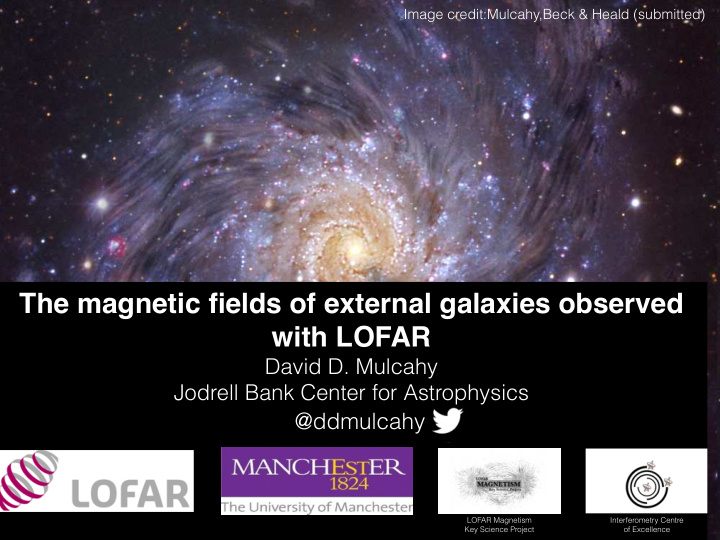



Image credit:Mulcahy,Beck & Heald (submitted) The magnetic fields of external galaxies observed � with LOFAR � � David D. Mulcahy Jodrell Bank Center for Astrophysics � @ddmulcahy � � � � LOFAR Magnetism Interferometry Centre Key Science Project of Excellence
Outline Why observe galaxies at low frequencies? � Observations of M51 with LOFAR HBA (Mulcahy, Horneffer et al. 2014) � Modelling the cosmic ray propagation in M51 (Mulcahy,Fletcher et al. 2016) �
Acknowledgements Full list of members can be found at http://lofar-mksp.com
Cosmic ray propagation at low frequencies <300 MHz • At low frequencies we are observing synchrotron emission originating from low energy cosmic ray electrons (CRE). � • In the Milky Way, propagation is mainly through diffusion-the result of scattering off turbulent magnetohydrodynamic waves and discontinuities of the interstellar plasma. � • Low energy CREs suffer less from synchrotron and inverse Compton losses. � • Cosmic ray lifetime is far longer at low frequencies and thus can travel further from their sites of origin. � • Can illuminate the magnetic field in the extended disk and halo.
NGC628 S-Band Why is observing the extended JVLA disk important? Magnetic fields may explain the rising part of the outer rotation curve. � Important to measure radial profiles of the turbulent and regular magnetic fields in order to constrain models. Mulcahy,Beck & Heald (submitted) Low frequency observations can help us measure at the furthest extents of the disk. � Only LOFAR can fit the bill! Ruiz-Granados et al.2010
M51 observed with LOFAR at 150 MHz Mulcahy, Horneffer et al. 2014
Magnetic field strength observed in the extended disk Total Magnetic Field Strength is found assuming equipartition between the energy densities of the magnetic field and cosmic rays (Beck & Krause 2005) � Assuming a ratio K between the numbers of cosmic-ray protons and electrons (usually K ≃ 100) � First time gives us estimates for the magnetic field strength in the extended disk for M51 (up to 15 kpc from centre)
Spectral index map of M51 between 1.4 GHz and 151 MHz Spectral Index Map Spectral Index Error Map
Extra galactic polarised sources with LOFAR 6 polarised sources observed in M51 field (approx 3X3 degrees) 1 polarised source per 1.7 square degrees Mulcahy et al. A&A, 2014
Propagation of Cosmic Ray Electrons Observe break in radio • continuum profile � Expect to see a ratio of • scale lengths between 151 MHz and 1.4 GHz for diffusion to be 1/1.74. � Expect to see a ratio of • scale lengths between 151 MHz and 1.4 GHz for streaming to be 1/3.04. � Observe a of ratio 1/1.6, • agrees with diffusion.
Motivation for modelling CR propagation • From observations, one can estimate the diffusion coefficient. However, this estimate is only good for an order of magnitude. � • Modelling the CR propagation equation to obtain the theoretical non-thermal spectrum and compare to the observed spectrum would give a better estimation of the diffusion coefficient. � • Explore the nature of CRe injection and confinement.
Modelling the cosmic ray electron propagation in M51 We can model the spectral index by solving the CR propagation equation numerically � Has been modelled extensively in our own galaxy but lacking in other galaxies - only analytical models Diffusion Energy Losses Injection ∂ t = Θ 1 ∂ N ∂ r 0 ( r 0 ∂ N ∂ ∂ r 0 ) + Φ ∂ ∂ E 0 [ E 0 2 B 0 2 ] + KQ ( r 0 ) E 0 − p r 0
Modelling the cosmic ray electron propagation in M51 we find that a diffusion coefficient of D r = D z ' 6 . 6 ⇥ 10 28 cm 2 s − 1 matches the observed spectrum very well. � The lifetime of CRE in M51 is about 11 Myr in the inner galaxy, increasing to over 88 Myr in the outer galaxy Mulcahy, Fletcher et al.2016
Testing the energy dependence of the diffusion coefficient • There is debate about the relevance of the energy dependence of the diffusion coefficient at low energies, which correspond to low radio frequencies. • Tested various energy dependence and starting energies. � • Energy dependence would not fit to observed values. Mulcahy, Fletcher et al.2016
Conclusions • LOFAR is now delivering high res, low noise images of nearby galaxies and we are now able for the first time to resolve different regions of galaxies. � • Able to detect the extended disk in M51 and measure the magnetic field strength � • Found that diffusion is the main mode of propagation of CREs in M51. The combination of observations and numerical modelling enable us to determine the diffusion coefficient and CRE escape time. � • Observing polarisation from star forming galaxies is extremely difficult due to depolarisation but we have detected polarised emission from radio galaxies.
Image credit:Mulcahy,Beck& Heald (submitted) � Any Questions? � � http://lofar-mksp.com � @ddmulcahy � � � � LOFAR Magnetism Interferometry Centre Key Science Project of Excellence
Recommend
More recommend